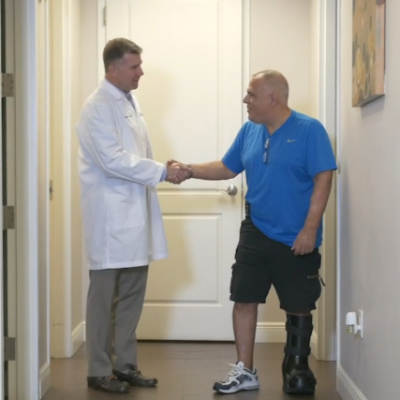CHARCOT FOOT - Causes and Treatment Options
Charcot foot presents as a red, hot, and swollen foot with multiple fractures and sometimes dislocations but is often associated with very little pain. This condition weakens the bones and develops in patients who have been diagnosed with peripheral neuropathy, which is a loss of sensation in your feet or legs due to damaged nerves.
Charcot foot, also known as Neurogenic Osteoarthropathy is an extremely complicated and potentially catastrophic condition effecting the foot, ankle and lower leg, which may result in amputation it not treated swiftly. In order for a patient to develop Charcot Foot, they must first have foot neuropathy. Treatment of Charcot foot is aimed at saving the leg by restoring stability to the foot and ankle so that the patient can bear weight and walk.
CHARCOT FOOT SYMPTOMS
Initial signs and symptoms of Charcot foot include extreme swelling and redness of the affected foot and ankle. There may be pain associated with Charcot foot but often the condition is painless due to underlying neuropathy. While there is often no identifiable event leading to this condition, simple trauma such as an ankle sprain or stubbing a toe may set off the development of a Charcot joint. Therefore, it is extremely important that any patient with peripheral neuropathy to immediately visit a board certified foot and ankle specialist should they notice any redness or swelling in their foot and ankle, or should they undergo any minor trauma to the foot and ankle
CHARCOT FOOT - DIAGNOSIS
Clinicians who do not specialize in the treatment of diabetic feet will often misdiagnose this as infection, which results in improper treatment and poor outcomes. Early diagnosis is paramount to the successful treatment of a Charcot joint. X-rays may demonstrate early joint subluxation, fragmentation or fractures. An MRI may also be suggested, as it is more sensitive to showing extensive edema throughout the bones neighboring the affected joints.
What are the causes of Charcot Foot?
There are multiple factors that could have caused your Charcot foot, including a sprain or fracture that wasn’t treated correctly, an infection or untreated sores on your feet and lower legs. For patients with peripheral neuropathy, a loss of sensation prevents the realization of broken bone or an infected sore. Without treatment, the foot is subjected to further trauma, resulting in the loss of calcium in your bones. This can lead to bone loss, which changes the shape of your foot as the mid section collapses. This is why Charcot foot is also referred to as “rocker-bottom” foot deformity.

CHARCOT FOOT SURGERY – What to Expect
Confusingly, Charcot foot surgery, in most cases, does not include nerve surgery on the foot. Instead, surgery on the Charcot foot and ankle involves repair of fractures and multiple joint fusions to stabilize the foot and ankle on the leg. Charcot foot surgery, requiring the internal and external fixation of bones, is a very involved, complex surgery with a relatively high failure rate.
CHARCOT FOOT TREATMENT – Conservative Options
If the condition is diagnosed early, Charcot foot treatment may require only immobilization and non-weight bearing or custom footwear. By offloading your weight, your podiatrist can help prevent the condition from getting worse or from further complications. You may also be required to wear a cast, before transition to custom orthopedic footwear.
However, in more severe cases, the foot becomes deformed and unstable requiring extensive reconstructive limb salvage surgery to treat the condition.
Watch one of our patient testimonials below about how Dr. Kyle Kinmon was able to avoid amputation on the affected foot. Make sure you get a second opinion from the doctors at Certified Foot and Ankle Specialists.
CHARCOT FOOT
The surgeons at Certified Foot and Ankle Specialists are experts at diagnosing Charcot foot and treating the condition, whether conservative or surgical intervention is required.



